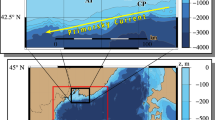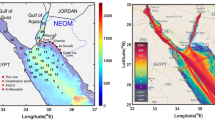Abstract
In case of oil spills due to disasters, one of the environmental concerns is the oil trajectories and spatial distribution. To meet these new challenges, spill response plans need to be upgraded. An important component of such a plan would be models able to simulate the behaviour of oil in terms of trajectories and spatial distribution, if accidentally released, in deep water. All these models need to be calibrated with independent observations. The aim of the present paper is to demonstrate that significant support to oil slick monitoring can be obtained by the synergistic use of oil drift models and remote sensing observations. Based on transport properties and weathering processes, oil drift models can indeed predict the fate of spilled oil under the action of water current velocity and wind in terms of oil position, concentration and thickness distribution. The oil spill event that occurred on 31 May 2003 in the Baltic Sea offshore the Swedish and Danish coasts is considered a case study with the aim of producing three-dimensional models of sea circulation and oil contaminant transport. The High-Resolution Limited Area Model (HIRLAM) is used for atmospheric forcing. The results of the numerical modelling of current speed and water surface elevation data are validated by measurements carried out in Kalmarsund, Simrishamn and Kungsholmsfort stations over a period of 18 days and 17 h. The oil spill model uses the current field obtained from a circulation model. Near-infrared (NIR) satellite images were compared with numerical simulations. The simulation was able to predict both the oil spill trajectories of the observed slick and thickness distribution. Therefore, this work shows how oil drift modelling and remotely sensed data can provide the right synergy to reproduce the timing and transport of the oil and to get reliable estimates of thicknesses of spilled oil to prepare an emergency plan and to assess the magnitude of risk involved in case of oil spills due to disaster.










Similar content being viewed by others
Explore related subjects
Discover the latest articles, news and stories from top researchers in related subjects.References
Adamo M, De Carolis G, De Pasquale V, Pasquariello G (2005) Combined use of SAR and MODIS imagery to detect marine oil spills, SAR image analysis, modeling, and techniques VII, edited by F. Posa. Proc SPIE 5980:153–164
Adamo M, De Carolis G, De Pasquale V, Pasquariello G (2009) Detection and tracking of oil slicks on sun-glittered visible and near infrared satellite imagery. Int J Remote Sens 30(24):6403–6427
Al-Rabeh AH (1994) Estimating surface oil spill transport due to wind in the Arabian Gulf. Ocean Eng 21(5):461–465
ASCE (1996) State-of-the-art review of modeling transport and fate of oil spills. J Hydraulic Eng 594–609
Audunson T (1980) The fate and weathering of surface oil from the Bravo blowout. Mar Environ Res 3(1):35–61
Bocard C, Castaing G and Gatellier C (1984). Chemical oil dispersion in trials at sea and in laboratory tests: the key role of dilution processes. In oil spill chemical dispersants: research, experience, and recommendations, edited by T. E. Allen, STP 840, 125–42. Philadelphia, PA: ASTM. 400
Brekke C, Solberg AH (2005) Oil spill detection by satellite remote sensing. Remote Sens Environ 95:1–13
Christiansen BM (2003) 3D oil drift and fate forecasts at DMI. Technical report. Danish Meteorological Institute, Copenhagen
Chust G, Sagarminaga Y (2007) The multi-angle view of MISR detects oil slicks under sun glitter conditions. Remote Sens Environ 107(1/2):232–239
Clark RN, Swayze GA, Leifer I (2010) A method for quantitative mapping of thick oil spills using imaging spectroscopy. U.S. Geological Survey Open-File Report Number 2010–1167
Coppini G, De Dominicis M, Zodiatis G, Lardner R, Pinardi N, Santoleri R, Colella S, Bignami F, Hayes DR, Soloviev D, s, Kallos G (2010) Hindcast of oil-spill pollution during the Lebanon crisis in the eastern Mediterranean, July–August 2006. Mar Pollut Bull. doi:10.1016/j.marpolbul.2010.08.021
Cox C, Munk W (1954) The measurement of the roughness of the sea surface from photographs of the sun’s glitter. J Opt Soc Am 44:838–850
De Carolis G, Adamo M, Pasquariello G, De Padova D, Mossa M (2013) Quantitative characterization of marine oil slick by satellite near-infrared imagery and oil drift modelling: the Fun Shai Hai case study. Int J Remote Sens 34:1838–1854
De Carolis G, Adamo M, Pasquariello G (2014) On the estimation of thickness of marine oil slicks from sun-glittered, near-infrared MERIS and MODIS imagery: the Lebanon oil spill case study. IEEE Trans Geosci Remote Sens 52(1):559–573
DHI Water & Environment (2008), MIKE 21 & MIKE 3 PA/SA—particle analysis and oil spill analysis module, user guide
DHI (2016) Mike 3 flow model: hydrodynamic module—scientific documentation, DHI Software 2016, Hørsholm, Denmark
Elhakeem A, Elshorbagy W, Chebbi R (2007) Oil spill simulation and validation in the Arabian Gulf with special reference to the UAE coast. J. Water, Air, Soil Poll 184:243–254
Elshorbagy W, Elhakeem A (2008) Risk assessment maps of oil spill for major desalination plants in the United Arab Emirates. Desalination 228:200–216
Engdahl M, Minchella A, Marinkovic P, Veci L and Lu J (2012): An ESA open source toolbox for scientific exploitation of sar data. In Proceedings of 2012 I.E. International Geoscience and Remote Sensing Symposium (IGARSS), Munich, Germany. 5322–5324
Fingas M, Brown C (2014) Review of oil spill remote sensing. Mar Pollut Bull 83(1):9–23
Gardiner C W (1985) Handbook of stochastic methods for physics chemistry and natural science, 13 of Springer Series in Synergetics, Springer, Berlin, Germany, 2nd edition
HIRLAM-5 Scientific Documentation (2012) HIRLAM-5 Project, c/o Per Undén SMHI, S-601 76 Norrkoping, SWEDEN
Hoge FE, Swift RN (1980) Oil film thickness measurement using airborne induced water Raman backscatter. Appl Opt 15:409–415
Hollinger JP, Mennella RA (1973) Oil spills: measurements of their distributions and volumes by multifrequency microwave radiometry. Science 181:54–56
Hu C, Li XF, Pichel WG, Muller-Karger FE (2009) Detection of natural oil slicks in the NW Gulf of Mexico using MODIS imagery. Geophys Res Lett 36:L01604. doi:10.1029/2008GL036119
Ivanov AY (2010) The oil spill from a shipwreck in Kerch Strait: radar monitoring and numerical modelling. Int J Remote Sens 31:17–18
Kankara RS and Subramanian BR (2007) Oil spill sensitivity analysis and risk assessment for gulf of Kachchh, India, using integrated. modeling J Coast Res 23, 5, 1251–1258
Kloeden PE, Platen E (1999) Numerical solution of stochastic differential equations, vol. 23. Springer, Berlin
Kostianoy AG, Bulycheva EV (2014) Numerical simulation of risks of oil pollution in the Southeastern Baltic Sea and in the Gulf of Finland. Modern problems of remote sensing of the Earth from space, V11, N 4, 56–75
Leifer I, Clark R, Jones C, Holt B, Svejkovsky J, Swayse G (2011) Satellite and airborne oil spill remote sensing: state of the art and application to the BP deepwater horizon oil spill. AMOP 270–295
Leifer I, Lehr WJ, Simecek-Beatty D (2012) State of the art satellite and airborne marine oil spill remote sensing: application to the BP deepwater horizon oil spill. Remote Sens of Environ 124:185–209. doi:10.1016/j.rse.2012.03.024
Lennon M, Babichenko S, Thomas N (2006) Detection and mapping of oil slicks in the sea by combined use of hyperspectral imagery and laser-induced fluorescence. European Association of Remote Sensing Laboratories eProc 5:120–128
Lončar G., Beg Paklar G., Janekovic I. (2012a) Numerical modelling of oil spills in the area of Kvarner and Rijeka Bay (The Northern Adriatic Sea. Journal of Applied Mathematics 2012, 497936, doi:10.1155/2012/497936
Lončar G, Leder N, Paladin M (2012b) Numerical modelling of an oil spill in the northern Adriatic. Oceanologia 54(2):143–173
Lu YC, Tian QJ, Wan JJ, Wang XC, Qi XP (2008) Experimental study on spectral responses of offshore oil slick. Chin Sci Bull 53:3937–3941
Lu Y, Li X, Tian Q, Han W (2012) An optical remote sensing model for estimating oil slick thickness based on two-beam interference theory. Opt Exp 20(22):24496–24504
Lu Y, Tian Q, Wang X, Zheng G, Li X (2013) Determining oil slick thickness using hyperspectral remote sensing in the Bohai Sea of China. Int. J. Digital. Earth 6(1):76–93
Mogensen N, Nielsen LG, Rekvad T (2003) Collision between Chinese bulk carrier Fu Shan Hai and Cypriot container vessel Gdynia. Casualty report, Copenhagen: Danish: Maritime Authority 33
Mossa M (2006) Field measurements and monitoring of wastewater discharge in sea water. Estuar Coast Shelf Sci 68:509–514
Mossa M (2010) Scraping the bottom of the barrel: what are the risks?”, Editorial of Hydrolink, n. 3, 2010, supplement to Journal of Hydraulic Research 48
Reed M, Turner A, Odulo T, Isaji S, Sortrom S. and Mathisen JO (1990) Field evaluation of satellite-tracked surface drifting buoys in simulating the movement of spilled oil in the marine environment. U.S. Department of the Interior, Minerals Management Service, MMS 90–0050
Reed M, Turned C, Odulo A (1994) The role of wind and emulsification in modelling oil spill and surface drifter trajectories. Spill Science Technology Bulletin 1:143–157
Reed M, Johansen O, Brandvik PJ, Daling P, Lewis A, Fiocco R, Mackay D, Prentki R (1999) Oil spill modeling towards the close of the 20th century: overview of the state of the art. Spill Science & Technology Bulletin 5:3–16
Rodi W (1987) Examples of calculation methods for flow and mixing in stratified fluids. J Geophys Res 92:5305–5328
Smagorinsky J (1993) Some historical remarks on the use of nonlinear viscosities. In: Galperin B, Orszag S (eds) Large eddy simulation of complex engineering and geophysical flows. Cambridge University Press, New York, pp. 3–36
Spaulding M (1988) A state-of-the-art review of oil spill trajectory and fate modeling. Oil and Chemical Pollution 4:39–55
Spaulding M, Kolluru V, Anderson E, Howlett E (1994) Application of three-dimensional oil spill model (WOSM/OILMAP) to hindcast the Braer spill. Spill Sci Technol Bull 1:23–35
Stephens MA (1970) Use of the Kolmogorov-Smirnov, Cramér-Von Mises and related statistics without extensive tables. J. R. Stat. Soc. Ser. B (Methodological) 32(1):115–122
Stolzenbach KD, Madsen EE, Adams A, Pollack A, Cooper C (1977) A review and evaluation of basic technique for predicting the behavior of surface oil slicks. Report no. 22. Department of Civil Engineering, Massachusetts Institute of Technology, Cambridge, Massachusetts
Svejkovsky J (2009) Development of a portable multispectral aerial sensor for real-time oil spill thickness mapping in coastal and offshore waters. Final report, Contract No.M07PC13205. Herndon, VA: U.S. Department of the Interior Minerals Management Service
Sykas D, Karathanassi V, Andreou Ch, Kolokoussis P (2011). Oil spill thickness estimation using unmixing methods. 3rd Workshop on Hyperspectral Image and Signal Processing: Evolution in Remote Sensing. IEEE
Vethamony P, Sudheesh K, Babu MT, Jayakumar S, Manimurali R, Saran AK (2007) Trajectory of an oil spill off Goa, eastern Arabian Sea: field observations and simulations. Environ Pollut 148:438–444
Verma P, Wate SR, Devotta S (2008) Simulation of impact of oil spill in the ocean—a case study of Arabian Gulf. Environ Monit Assess 146:191–201
Wettle M, Daniel PJ, Logan GA, Thankappan M (2009) Assessing the effect of hydrocarbon type and thickness on a remote sensing signal: a sensitivity study based on the optical properties of two different oil types and the HYMAP and quickbird sensors. Remote Sens Environ 113(9):2000–2010
Wilmott CJ (1981) On the validation of models. Phys Geogr 2:184–194
Author information
Authors and Affiliations
Corresponding author
Ethics declarations
Competing interests
The authors declare that they have no competing interests.
Additional information
Responsible editor: Marcus Schulz
Capsule abstract
The aim of the present paper is to demonstrate that significant support to oil slick monitoring can be obtained by the synergistic use of oil drift models and remote sensing observations.
Rights and permissions
About this article
Cite this article
De Padova, D., Mossa, M., Adamo, M. et al. Synergistic use of an oil drift model and remote sensing observations for oil spill monitoring. Environ Sci Pollut Res 24, 5530–5543 (2017). https://doi.org/10.1007/s11356-016-8214-8
Received:
Accepted:
Published:
Issue Date:
DOI: https://doi.org/10.1007/s11356-016-8214-8




